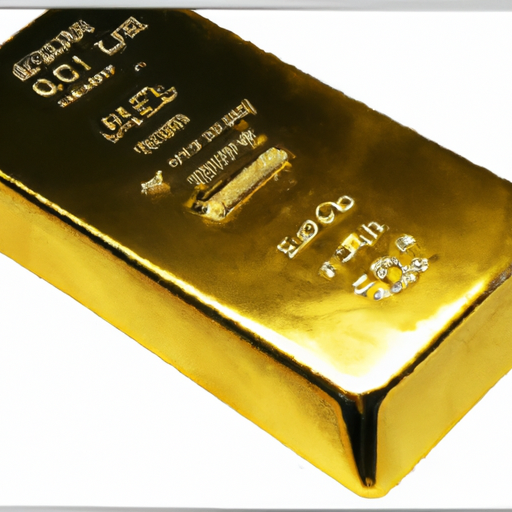When it comes to investing in gold, it’s important to consider your investment goals and how they shape your overall strategy. Understanding your time horizons can make a significant difference in the decisions you make as an investor. Whether you’re looking for short-term gains or long-term stability, the length of time you plan to hold onto your gold can determine the best approach. In this article, we’ll explore how different investment goals can influence your strategy and help you make informed decisions when it comes to investing in gold. So, grab a cup of coffee and let’s dive into the fascinating world of gold investment.
Short-Term Investment Goals
Introduction to short-term investment goals
When it comes to investing in gold, it’s important to have clear goals in mind. Short-term investment goals typically refer to financial objectives that can be achieved within a relatively short time frame, usually one to three years. These goals can vary widely depending on an individual’s circumstances and risk tolerance. Whether you’re saving for a down payment on a house or planning for a dream vacation, having a clear understanding of your short-term investment goals is crucial for developing an effective strategy.
The impact of short-term investment goals on gold strategy
Short-term investment goals can have a significant impact on the way you approach your gold investment strategy. When setting short-term goals, it’s important to consider the liquidity of your investments. Gold, while a valuable asset, is not as easily convertible to cash as other financial instruments like stocks or bonds. Therefore, if you have a short-term goal that requires access to funds on short notice, it might be wise to allocate a smaller portion of your portfolio to gold.
Strategies for short-term gold investment
There are several strategies that can be employed when it comes to short-term gold investment. One popular approach is to invest in gold ETFs (Exchange-Traded Funds) or gold mutual funds. These investment vehicles provide exposure to the price movement of gold without the need for physical ownership. Another strategy is to consider investing in gold mining stocks or gold-related equities. These stocks can offer potential capital appreciation and can be more liquid than physical gold.
Common challenges and risks in short-term gold investment
While gold can be a valuable asset for short-term investment goals, there are also some challenges and risks to be aware of. One challenge is the volatility of gold prices. In the short term, the price of gold can experience significant fluctuations, which may impact the value of your investment. Additionally, there may be costs associated with buying and selling gold, such as dealer markups or transaction fees. It’s important to consider these factors and consult with a financial advisor before making any investment decisions.
Medium-Term Investment Goals
Introduction to medium-term investment goals
Medium-term investment goals typically refer to financial objectives that can be achieved within a time frame of three to five years. These goals can include saving for a child’s education, starting a small business, or making a significant purchase like a new car. As with any investment strategy, it’s important to align your medium-term goals with your risk tolerance and time horizon.
The impact of medium-term investment goals on gold strategy
Medium-term investment goals can shape your gold investment strategy in various ways. One factor to consider is the potential for capital appreciation over the medium term. Gold has historically been viewed as a store of value and a hedge against inflation, which can make it an attractive option for protecting purchasing power over time. Additionally, the timeframe of medium-term goals allows for a longer investment horizon, which can help mitigate some of the short-term volatility associated with gold prices.
Strategies for medium-term gold investment
There are several strategies that can be employed for medium-term gold investment. One approach is to invest in physical gold, such as bullion or coins. This allows you to have direct ownership and control over your investment. Another option is to invest in gold mining companies or gold-related ETFs or mutual funds. These investments provide exposure to the gold market while potentially offering diversification benefits. It’s important to consider your risk tolerance and financial goals when choosing a strategy that aligns with your medium-term investment objectives.
Considerations for diversification and asset allocation
Diversification and asset allocation are important concepts to consider when developing a medium-term gold investment strategy. Diversification refers to spreading your investments across different asset classes, sectors, and geographic regions. This can help reduce the impact of any one investment performing poorly. When it comes to gold, it’s important to consider its role in your overall portfolio. Gold can offer diversification benefits due to its low correlation with other asset classes, such as stocks and bonds. However, it’s important to ensure that your allocation to gold aligns with your risk tolerance and overall investment goals.
Long-Term Investment Goals
Introduction to long-term investment goals
Long-term investment goals typically refer to financial objectives that have a time horizon of five years or more. These goals can include saving for retirement, funding a child’s education, or leaving a financial legacy for future generations. When it comes to long-term goals, it’s important to have a well-defined investment plan that takes into account your risk tolerance, time horizon, and potential growth opportunities.
The impact of long-term investment goals on gold strategy
Long-term investment goals can greatly influence your gold investment strategy. Gold has historically been viewed as a long-term store of value and a hedge against inflation. As a result, many investors turn to gold as a means of preserving purchasing power over the long term. When considering your long-term goals, it’s important to evaluate the potential role of gold in your portfolio and its ability to provide stability and diversification.
Strategies for long-term gold investment
There are several strategies to consider when it comes to long-term gold investment. One approach is to invest in physical gold, such as bars or coins, and hold them for the long term. This allows you to have direct ownership and control over your investment. Another strategy is to invest in gold mining stocks or gold-related ETFs or mutual funds. These investments provide exposure to the gold market while potentially offering growth opportunities. It’s important to carefully consider your risk tolerance and investment goals when choosing a strategy that aligns with your long-term objectives.
The role of gold in portfolio preservation
Gold has long been considered a safe haven asset and a means of preserving wealth over the long term. When it comes to long-term investment goals, the role of gold in portfolio preservation becomes particularly important. Gold has demonstrated a track record of holding its value during times of economic uncertainty and market volatility. By including gold in your long-term investment strategy, you can potentially reduce the overall risk of your portfolio and provide a buffer against market downturns.
Risk Tolerance and Time Horizons
Understanding risk tolerance
Risk tolerance refers to an individual’s willingness and ability to take on risk in their investment portfolio. It is influenced by factors such as personal financial situation, investment knowledge, and time horizon. It’s important to understand your risk tolerance before making any investment decisions, as it can impact the types of investments you choose and the allocation of your portfolio.
The relationship between risk tolerance and time horizons
There is a strong relationship between risk tolerance and time horizons in investing. Generally, individuals with longer time horizons can afford to take on more risk in their portfolios, as they have a longer period to recover from any potential losses. Conversely, individuals with shorter time horizons, such as those saving for a short-term goal, may have a lower risk tolerance and prefer more conservative investment options. Understanding your own risk tolerance and time horizon is essential for developing an investment strategy that aligns with your goals and comfort level.
How risk tolerance influences gold investment strategies
Risk tolerance plays a crucial role in shaping gold investment strategies. Gold is often viewed as a relatively lower-risk asset compared to stocks or real estate. However, it’s important to recognize that gold prices can still experience volatility and fluctuations in value. Individuals with a low risk tolerance may prefer to allocate a larger portion of their portfolio to gold as a means of preserving capital and reducing overall portfolio risk. On the other hand, individuals with a higher risk tolerance may choose to allocate a smaller portion of their portfolio to gold and focus on higher-risk, potentially higher-reward investment opportunities.
Diversification and Gold Investment
The importance of portfolio diversification
Portfolio diversification is a risk management strategy that involves spreading investments across different asset classes, sectors, and geographic regions. The goal of diversification is to reduce the impact of any one investment performing poorly on the overall portfolio. By diversifying, investors can potentially improve their risk-adjusted returns and protect against losses in specific areas of the market.
How gold can contribute to diversification
Gold can play a significant role in portfolio diversification due to its historically low correlation with other asset classes such as stocks and bonds. When stocks or other financial assets are experiencing volatility or a downturn, gold has often demonstrated the ability to hold its value or even appreciate. By including gold in your investment portfolio, you can potentially reduce the overall risk and enhance the returns by diversifying across different asset classes.
Strategies for incorporating gold into a diversified portfolio
There are several strategies for incorporating gold into a diversified portfolio. One approach is to determine an appropriate allocation to gold based on your risk tolerance, financial goals, and investment timeframe. This can be achieved by allocating a fixed percentage of your portfolio to gold or by using a dynamic approach that varies the allocation based on market conditions. It’s important to regularly monitor and rebalance your portfolio to ensure that your allocation to gold remains in line with your overall investment strategy.
Market Conditions and Time Horizons
Understanding market cycles
Market cycles refer to the periods of growth and decline in financial markets. These cycles are influenced by a variety of factors, including economic conditions, investor sentiment, and geopolitical events. Understanding market cycles is important for investors as it can help inform investment decisions and provide insights into potential opportunities and risks.
The impact of market conditions on gold investment
Market conditions can have a significant impact on gold investment. In times of economic uncertainty or geopolitical tensions, gold has often been viewed as a safe haven asset and a store of value. During these periods, demand for gold tends to increase, which can drive up prices. On the other hand, during periods of economic stability or positive market conditions, the demand for gold may decrease, leading to potential price declines. Monitoring market conditions and staying informed about global events can help investors make more informed decisions when it comes to gold investment.
Strategies for navigating different market conditions
Navigating different market conditions requires a flexible investment strategy. During periods of economic uncertainty or market volatility, investors may choose to increase their allocation to gold as a means of diversification and capital preservation. Conversely, during periods of economic growth and stability, investors may consider reducing their allocation to gold and focusing on other higher-growth opportunities. Adapting your investment strategy based on market conditions can help optimize your portfolio performance and protect against potential losses.
Factors Influencing Gold Prices
Introduction to factors influencing gold prices
Gold prices are influenced by a variety of factors, ranging from economic indicators to geopolitical events. Understanding these factors is important for investors as it can provide insights into potential price movements and help inform investment decisions.
Key economic indicators to monitor
Several key economic indicators can have a significant impact on gold prices. These indicators include inflation, interest rates, and the strength of the US dollar. Inflation erodes the value of fiat currencies and can drive up demand for gold as a hedge against inflation. Changes in interest rates can also impact gold prices, as higher interest rates can make other investments more attractive relative to gold. Additionally, the strength of the US dollar can influence gold prices, as gold is priced in US dollars on global markets.
Geopolitical factors and their effect on gold
Geopolitical events can have a profound effect on gold prices. Political unrest, wars, and global conflicts can increase uncertainty and drive up demand for safe-haven assets like gold. In times of geopolitical instability, investors often turn to gold as a store of value and a means of preserving capital. Monitoring geopolitical events and staying informed about global affairs can help investors anticipate potential price movements and make informed investment decisions.
How time horizons affect the importance of different factors
The importance of different factors influencing gold prices can vary depending on an investor’s time horizon. Short-term investors may be more focused on market sentiment and technical analysis, while long-term investors may pay closer attention to macroeconomic trends and geopolitical developments. Regardless of the time horizon, it’s important to consider a comprehensive range of factors when analyzing gold prices and making investment decisions.
Strategies for Gold Accumulation
Introduction to gold accumulation
Gold accumulation refers to the process of gradually building up your holdings of gold over time. This can be achieved through regular investments or by taking advantage of market opportunities. Gold accumulation is a long-term investment strategy that aims to capitalize on the potential growth and preservation of value offered by gold.
The power of compounding and regular investment
One strategy for gold accumulation is to take advantage of the power of compounding and regularly invest a fixed amount of money into gold over time. By investing a consistent amount at regular intervals, investors can potentially benefit from the long-term appreciation of gold prices. Regular investment also helps mitigate the impact of short-term price fluctuations, as investors are buying both during periods of price highs and lows.
Dollar-cost averaging as a strategy
Dollar-cost averaging is a strategy that involves investing a fixed amount of money into gold at regular intervals, regardless of the current price. This approach allows investors to effectively average out the cost of their investments over time. During periods of higher gold prices, the fixed investment amount will buy fewer ounces, while during periods of lower prices, the fixed investment amount will buy more ounces. Dollar-cost averaging can help reduce the impact of market volatility and potentially enhance long-term returns.
Choosing between physical gold and gold-backed securities
When it comes to gold accumulation, investors have the option to invest in physical gold or gold-backed securities. Physical gold, such as bars or coins, provides direct ownership and control over the investment. However, it may require additional costs for storage and safekeeping. Gold-backed securities, such as ETFs or mutual funds, offer exposure to the price movement of gold without the need for physical ownership. These securities can be more liquid and cost-efficient compared to physical gold. The choice between physical gold and gold-backed securities depends on factors such as convenience, cost, and personal preference.
Monitoring and Adjusting Your Strategy
Regularly evaluating your investment goals
Regularly evaluating your investment goals is an essential part of successful investing. It’s important to review your short-term, medium-term, and long-term goals periodically to ensure they are still relevant and aligned with your financial aspirations. This evaluation process allows you to assess whether your investment strategy needs adjustment or if you need to realign your portfolio to better achieve your goals.
Monitoring gold market trends
Monitoring gold market trends is crucial for investors who have exposure to gold or are considering adding gold to their portfolio. Keeping an eye on gold prices, market sentiment, and news related to the gold industry can provide valuable insights into potential price movements and upcoming market opportunities. Staying informed and up-to-date on market trends can help you make more informed investment decisions and potentially enhance your returns.
Making adjustments based on changing circumstances
Investment strategies should be flexible and adaptable to changing circumstances. As your financial goals, risk tolerance, or market conditions evolve, it may be necessary to make adjustments to your gold investment strategy. This could include rebalancing your portfolio, changing your allocation to gold, or reassessing the overall risk profile of your investments. Regularly reviewing and adjusting your strategy ensures that it remains aligned with your goals and helps maximize your investment potential.
Seeking professional advice when needed
Investing in gold, like any other investment, can be complex and requires careful consideration. If you’re unsure about any aspect of your gold investment strategy, it’s always a good idea to seek professional advice. Financial advisors and experienced professionals can provide valuable insights and guidance tailored to your specific needs and circumstances. Consulting with experts can help ensure that you make informed decisions and navigate the complexities of the gold market with confidence.
Conclusion
In conclusion, time horizons play a crucial role in shaping your gold investment strategy. Short-term, medium-term, and long-term investment goals can influence the allocation, diversification, and risk management strategies when it comes to investing in gold. Understanding your risk tolerance and time horizon is essential for developing a well-defined investment plan that aligns with your financial goals. By carefully considering these factors and monitoring market conditions, you can build a successful gold investment strategy that enhances your portfolio’s performance, preserves your wealth, and provides stability in the face of uncertainty. Remember to regularly evaluate your investment goals, stay informed about market trends, and seek professional advice when needed to ensure that your strategy remains effective and aligned with your evolving financial aspirations.



